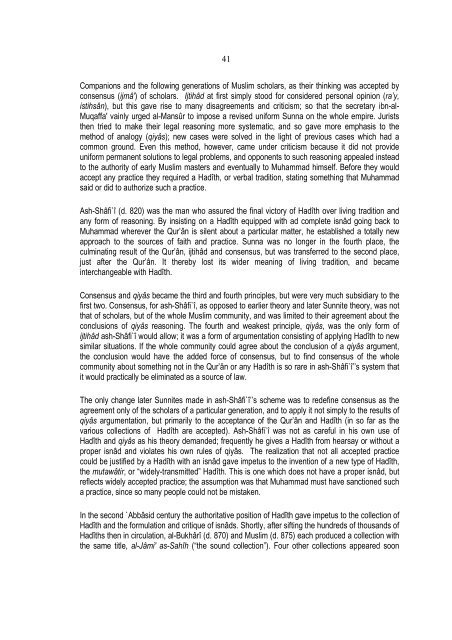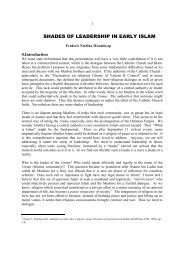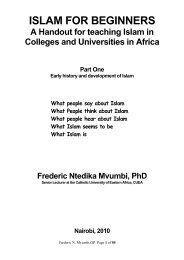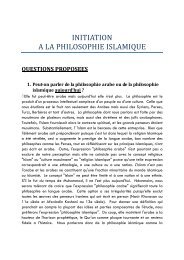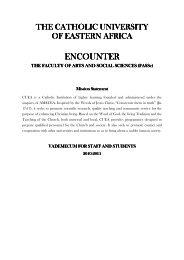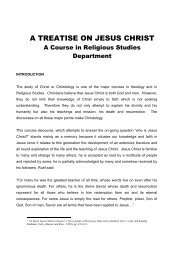INTRODUCTION TO ISLAMIC THEOLOGY.pdf - CUEA
INTRODUCTION TO ISLAMIC THEOLOGY.pdf - CUEA
INTRODUCTION TO ISLAMIC THEOLOGY.pdf - CUEA
Create successful ePaper yourself
Turn your PDF publications into a flip-book with our unique Google optimized e-Paper software.
41Companions and the following generations of Muslim scholars, as their thinking was accepted byconsensus (ijmâ') of scholars. Ijtihâd at first simply stood for considered personal opinion (ra’y,istihsân), but this gave rise to many disagreements and criticism; so that the secretary ibn-al-Muqaffa' vainly urged al-Mansûr to impose a revised uniform Sunna on the whole empire. Juriststhen tried to make their legal reasoning more systematic, and so gave more emphasis to themethod of analogy (qiyâs); new cases were solved in the light of previous cases which had acommon ground. Even this method, however, came under criticism because it did not provideuniform permanent solutions to legal problems, and opponents to such reasoning appealed insteadto the authority of early Muslim masters and eventually to Muhammad himself. Before they wouldaccept any practice they required a Hadîth, or verbal tradition, stating something that Muhammadsaid or did to authorize such a practice.Ash-Shâfi`î (d. 820) was the man who assured the final victory of Hadîth over living tradition andany form of reasoning. By insisting on a Hadîth equipped with ad complete isnâd going back toMuhammad wherever the Qur’ân is silent about a particular matter, he established a totally newapproach to the sources of faith and practice. Sunna was no longer in the fourth place, theculminating result of the Qur’ân, ijtihâd and consensus, but was transferred to the second place,just after the Qur’ân. It thereby lost its wider meaning of living tradition, and becameinterchangeable with Hadîth.Consensus and qiyâs became the third and fourth principles, but were very much subsidiary to thefirst two. Consensus, for ash-Shâfi`î, as opposed to earlier theory and later Sunnite theory, was notthat of scholars, but of the whole Muslim community, and was limited to their agreement about theconclusions of qiyâs reasoning. The fourth and weakest principle, qiyâs, was the only form ofijtihâd ash-Shâfi`î would allow; it was a form of argumentation consisting of applying Hadîth to newsimilar situations. If the whole community could agree about the conclusion of a qiyâs argument,the conclusion would have the added force of consensus, but to find consensus of the wholecommunity about something not in the Qur’ân or any Hadîth is so rare in ash-Shâfi`î’’s system thatit would practically be eliminated as a source of law.The only change later Sunnites made in ash-Shâfi`î’’s scheme was to redefine consensus as theagreement only of the scholars of a particular generation, and to apply it not simply to the results ofqiyâs argumentation, but primarily to the acceptance of the Qur’ân and Hadîth (in so far as thevarious collections of Hadîth are accepted). Ash-Shâfi`î was not as careful in his own use ofHadîth and qiyâs as his theory demanded; frequently he gives a Hadîth from hearsay or without aproper isnâd and violates his own rules of qiyâs. The realization that not all accepted practicecould be justified by a Hadîth with an isnâd gave impetus to the invention of a new type of Hadîth,the mutawâtir, or “widely-transmitted” Hadîth. This is one which does not have a proper isnâd, butreflects widely accepted practice; the assumption was that Muhammad must have sanctioned sucha practice, since so many people could not be mistaken.In the second `Abbâsid century the authoritative position of Hadîth gave impetus to the collection ofHadîth and the formulation and critique of isnâds. Shortly, after sifting the hundreds of thousands ofHadîths then in circulation, al-Bukhârî (d. 870) and Muslim (d. 875) each produced a collection withthe same title, al-Jâmi' as-Sahîh (“the sound collection”). Four other collections appeared soon


